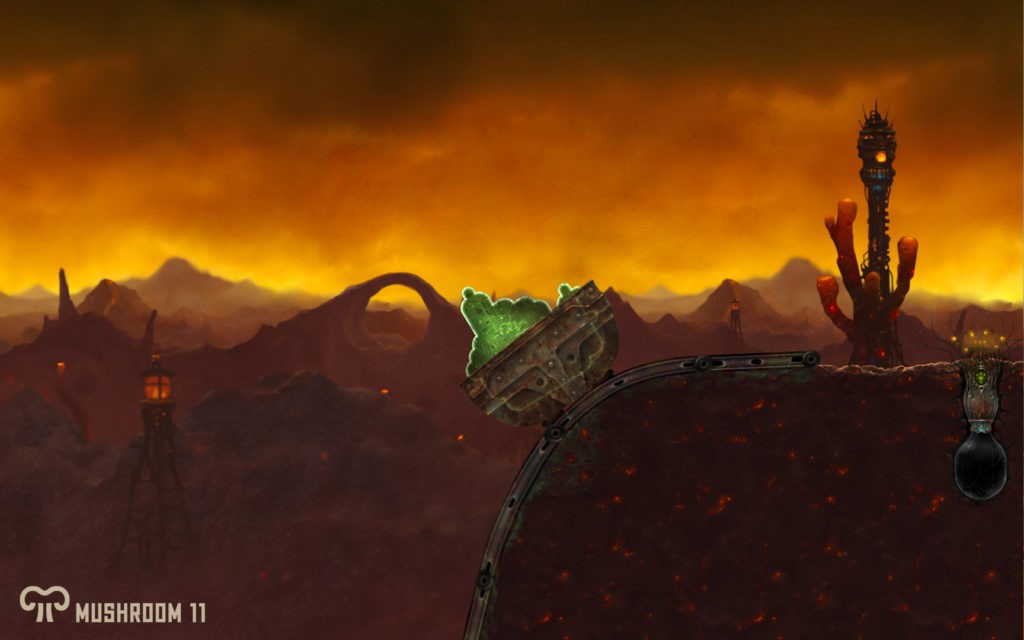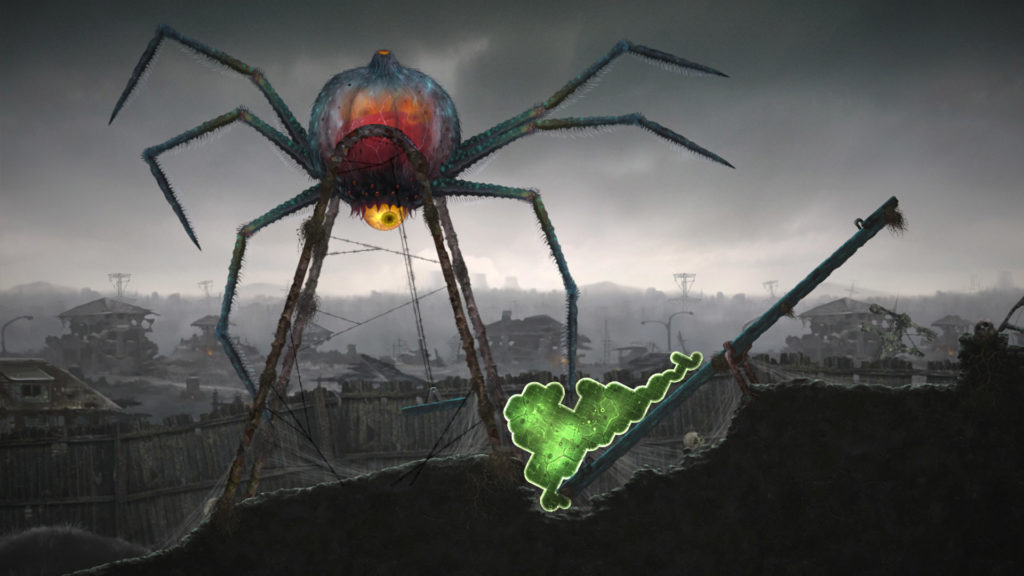
Mushroom 11 – Game Audio Review
Reviewed by Doug Waters
Edited by Sam Hughes
Developer: Untame
Composer: The Future Sound of London
Sound Design: Power Up Audio
Reviewed on: Mac, Steam
Originally developed as part of 2012’s Global Game Jam, Untame’s award winning Mushroom 11 is an incredibly unique puzzle-platformer set in a post-apocalyptic world, populated by all manner of weird and wonderful creatures. Instead of controlling the player character using arrow keys, as done so in other platformers, you must mold an amorphous blob into shapes to solve puzzles and traverse the landscape of the game.
From what I’ve played of the game so far, reaching level 6, I’ve yet to come across any dialogue. Because of this it’s my understanding that there is none in the game; so if you’re interested in voice acting, let me stop you right here. However, the game doesn’t suffer from this lack of dialogue, in fact I think that the introduction of voice over might somehow ruin the sense of mystery the player feels going throughout each level. So without further ado, let’s dive in and explore the sound design and music all of which was implemented using Firelight Technologies’ audio middleware solution, FMOD Studio.

Sound Design
Upon first learning of the unique mechanics of Mushroom 11 my initial concern was that whatever sound, if any, was used for the morphing of the player ‘blob’ would become repetitive and thus annoying to continually listen to. However, the sounds that I was presented with were quite the opposite! What I can only describe as a moist ‘squishing’ sound, is implemented and controlled in the game in a way I could never describe as being invasive to the player’s experience; it’s neither in your face, nor does it sit so far in the background behind other sounds that it’s unnoticeable.
The sound itself doesn’t appear to be a loop that is simply started or stopped, but a more complex library of samples randomly selected by the system (maybe with some randomised pitch and volume as well). This, of course, combats any repetitiveness that might be caused by just using a loop. In addition to this, whilst sculpting shapes out of the ‘blob’, at points when it has less mass, the ‘squishing’ sounds lower and diminish. This however becomes almost a flourish in sound as the player organism grows to full mass. It’s my belief that the game engine is constantly looking at the changes in character mass to tell FMOD Studio to shape the squishing sounds with a low pass filter, possibly with some pitch control as well. However, I might be completely wrong! Regardless, whatever system is being used it makes for an oddly satisfying sound.

At the end of each level the player will be required to utilise sculpting skills they’ve learnt on their journey so far to defeat a uniquely bizarre and mutated boss. The sound design of the ‘vocalisations’ given to each boss truly gives these creatures size and instills an essence of fear within the player. Just like how the bosses themselves might vaguely resemble real world fauna, although mutated almost beyond recognition, so too the roars and screeches sound puzzlingly familiar and yet are manipulated and processed in such a way that the player can’t quite determine their origin.
Another area of the sound design that I’ve felt truly shines through is the machinery and the sounds of beaten and rusted metal objects. The audio that plays upon interacting with such objects gives them weight and size, the machinery sounds like it’s dying at times, metal girders creak and groan and the impacts brilliantly match the action of the visuals.
Though, much as I loved everything I’ve mentioned thus far, there were a few elements that I felt let themselves down. In particular I noticed that there was a background loop of blowing winds; this however didn’t seem to match the visuals. At times it sounded like wind was buffeting the side of a building, yet there were no building in sight, or you could hear the sound but none of the objects in the game such as plants or hanging chains moved with the wind. It just seemed so at odds, not only with the visuals, but when compared to the aforementioned metal impacts that seemed to so closely match the player’s interactions. Although, it seems that the wind was used so that the environment is never completely, unnaturally silent; it also lends itself towards the idea of an abandoned wasteland. Cue the tumbleweed.

I also found the sound of enemy projectile fireballs to be a little repetitive; this of course was incredibly noticeable when multiple fireballs were fired at once. This leads to an almost cacophony of sound in some moments. I myself am a little torn with how I feel about this, there seems to be a break in the continuity in terms of audio design when comparing these fireballs to certain other elements; and yet, whether it was intentional or not, this cacophony seems to work for conveying a sense of imposing danger.
On a very minor note, I found that the flourishing sound upon reaching a checkpoint in a level was a little too loud in the mix for my liking, but of course this is just a personal preference and others may feel that it’s already at an appropriate volume. Alas, once donned, my mixing hat cannot be removed! Overall I’ve been incredibly impressed with the sound design and audio systems that have been created for and used in Mushroom 11. All in all, very pleasantly surprising, the team at Power Up Audio have done a great job!

Music
All of the music in Mushroom 11 is written and licensed by the electronic music duo Garry Cobain and Brian Dougans, otherwise known by their band name, The Future Sound of London.
Beyond the changing visuals, each of the seven differing levels are further characterised with a distinctive looping track. These pieces of music are very eerie in tones, which once again perfectly matches the weird mutated post-apocalyptic setting; Indeed some of the instrumentation sounds very much like they could be elements in the level’s environment, making the sound design and music seemingly weave in and out of each other.
Despite the fact that the general level music is just a single loop, there’s no layering etc., it rarely feels repetitive or intrusive to be considered annoying. The music only changes to a new piece when the player is getting near to the level’s boss battle and this happens before you even see the boss, which coincidentally works well for communicating to the player that they’re nearing the end of the level.
The boss battle music that is introduced is more intense sounding, both in terms of instrumentation and pace, making the entire sequence feel more adrenaline fuelled than ‘general’ gameplay. Musically it works perfectly with the battle and reminds me of something akin to a score for a classic 80’s sci-fi film; some of the synthetic elements deeply reminded me of parts of Vangelis’ score for 1982 classic, Blade Runner.
Finally, after having defeated each boss the music transitions to a light ambient piece and not to the level specific track used prior to the battle. The crossfading transition between the two pieces might not always be the smoothest, yet this is largely masked by the dying sounds of the bosses as mentioned previously.
Despite the fact that the music isn’t incredibly reactive to gameplay, indeed the game doesn’t really call for that level of interactivity in it’s score, I cannot deny that The Future Sound of London seem to have been the perfect choice for the music!

Conclusion
For fans of platformers, Mushroom 11 is a simply must have; unique mechanics, vibrant and beautifully detailed art style and some great sound design and music obviously! It can take a little while to get used to the distinctive controls; some puzzles can take many multiple attempts and can be infuriating at times, yet I found this only fueled my drive to complete them and felt incredibly rewarding upon achieving success. If you’re bored of the same old platformer mechanics again and again, then make sure you check out Mushroom 11!
You can pick up Mushroom 11 on Steam, available for both Mac and PC.
Were there any audio moments in Mushroom 11 that you particularly enjoyed? What’re your thoughts on the sound design and music choices discussed here? We’d love to hear your feedback and opinions!
LINKS
Mushroom 11 & Untame
Power Up Audio:
http://powerupaudio.com/projects
The Future Sound of London:
http://www.futuresoundoflondon.com
We hope you enjoyed Doug’s review check out others in our Reviews section :). Don’t forget to sign up to ourMonthly Newsletter to make sure you don’t miss out on our reviews and interviews.
The Sound Architect



